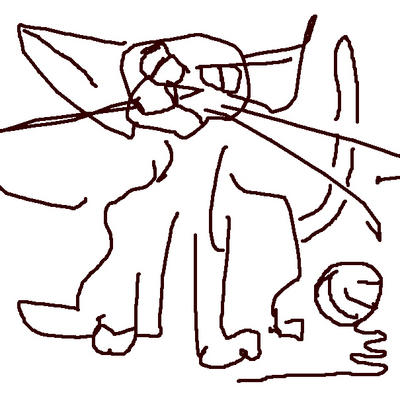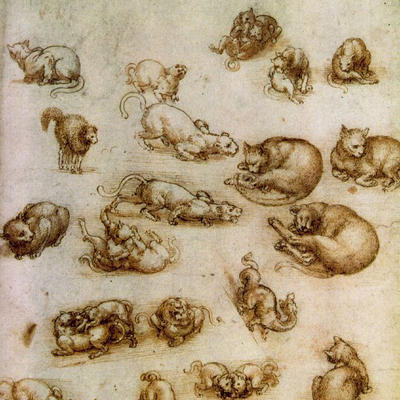Drawing Animals - Marshall Vandruff
Last night I attended the first of four nights in a Crash Course In Animal Drawing, taught by Marshall Vandruff, whose Comic-Con sketchbook panel we wrote about last month.
Is the class worth it? Is Marshall a great teacher? I'll let YOU decide:
Is the class worth it? Is Marshall a great teacher? I'll let YOU decide:
BEFORE THE CLASS

AFTER THE CLASS

...AND THAT AFTER ONLY ONE NIGHT!
I'm kidding, of course. The second "Study of Cat Movements and Positions" is by Sergio Aragones.
Marshall presents solid information enthusiastically, maintaining a nicely modulated balance between theory and practicality.
One of Marshall's great tips was: "Always draw with your left hand. NEVER your right! Leonardo was left-handed. What does that tell you?"
A girl in the class had been in a recent accident, her left arm in a cast. She wondered if she might, until the cast came off, use her right hand for drawing.
"GET OUT!!" Marshall screamed.
The girl left sobbing.
I'm lying again. I should wash my mouth out with soap. But that wouldn't make sense, because washing out the mouth with soap is a treatment for swearing, not for lying. And the only thing it would be likely to accomplish is to make people say "Neal is sitting at his computer, eating soap. Should we call someone?"
The seminar so far seems to be excellent. I count myself fortunate for landing in it. I had several "Aha!" moments as I drew along with the exercises, and a single "Aha!" moment is worth the price of admission. Driving home I found myself thinking "Animal drawing is all so obvious and simple!" Then I got home and looked at my cats.
Do cats even have bones? Marshall said they do, but I'm not so sure.
I'm learning those things I have seen in books for years, but just didn't have the fortitude--or the multiple personality disorder--to fully teach myself. I really think it's vital--skip ahead if you're sick of hearing me say this--to be among real live people who are attempting the same thing you are. And there is something irreplaceable in the transmission from teacher to student. There is more occurring in teaching than just a mere downloading of data. I suspect that there is some kind of other "unseen element" at work. Perhaps some of it is just a kind of unconscious imitation, but something does seem to "rub off" from a good teacher that is well outside words and diagrams and helpful hints.
In "Zen In The Art Of Archery", the author Eugene Herrigel talks about his trials in learning the Japanese art of kyudo. When a student was in a rut, the Master might simply pick up the student's bow and pull on the bowstring, or shoot a single arrow with it, then hand it back to the student. The bow would invariably shoot more accurately after that. I'm sure there are sound psychological reasons for this phenomenon, but I imagine it holds true through multiple disciplines. No human being can get what he needs all by himself. He requires a group. The transmission of ideas, the sharing of revelations transforms the group entire, which in turn transforms the individual, then back again.
The image of a newborn colt comes to mind--maybe because there were an awful lot of horses to draw in Marshall's seminar. Or maybe because last week I went riding for only the second time in my life. Or maybe because some morning's I wake up feeling like I'm covered in placenta. In any case, the colt doesn't learn to stand up because there is information imparted from its mother. Perhaps it's entirely hard-wired into the newborn's brain, but I suspect it helps that its mother is already standing herself, modeling a mature example. I wonder: Do colts learn to stand as easily if they are isolated from their mothers? To paraphrase Mark Bryan of "The Artist's Way": "The Self-Made Man is a myth."

